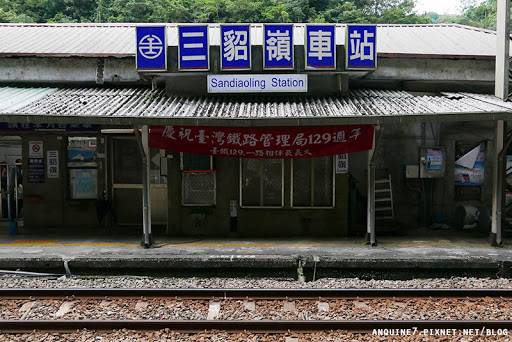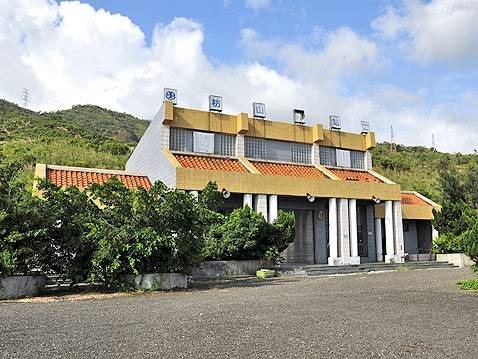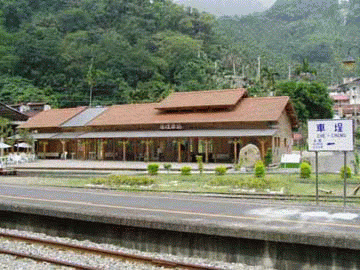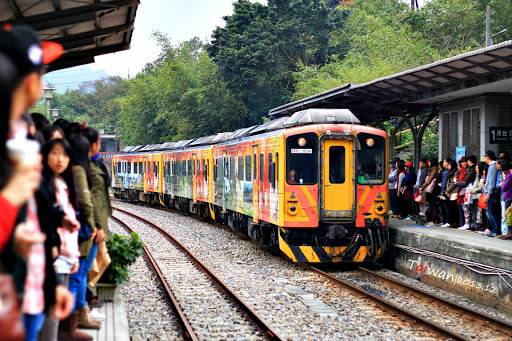Houtong (Cat Village) Station
As soon as you step out of Houtong Train Station, you are greeted by a plethora of 'cats'. Houtong Station is one of the few Taiwan Railways stations that still retains a rustic and rural charm. The abandoned mining company facilities around the station add a sense of history. The village is surrounded by green mountains, with Japanese-style houses and a stream flowing through the village. There's also the unique cat stationmaster 'Black Nose'!
Sandiaoling Station
Sandiaoling Station is located at the junction of the Yilan Line and the Pingxi Line, with the famous 'Cat Village' Houtong as its neighboring station. The station's main entrance faces grasslands and a river valley, while the other end of the platform is adjacent to a mountain wall, flanked by abandoned houses. The coal washing pollution of the past is no longer present, replaced by the stunning sight of emerald green water flowing among the peculiar rock formations in the valley. The platform next to the mountain wall often sees spring water trickling down after rain, earning it the nickname 'Waterfall by the Platform.' Visiting the Pingxi Line from Sandiaoling Station is also a great option.
Yilan Station
Many cities in Taiwan transform old train stations into railway cultural squares, such as Kaohsiung Station which retains the appearance from the Japanese colonial period. In addition to preserving history and culture, it also keeps the memories of the past and the hopes and expectations for the future. Yilan Station, on the other hand, chose to transform the former railway bureau area into a city square themed around Jimmy Liao's picture books, making it one of the few combinations of two completely different styles.
Dongshan Railway Station
Almost every station on the Eastern Line offers beautiful scenery. The design of Yilan's Dongshan Station is inspired by the concept of a 'melon shed,' with metal strips simulating the overlapping arcs of vines covering the station, creating a very unique shape. The best place to appreciate Dongshan Station is from the Dongshan River Forest Park on the north side of the station. By climbing onto the railway culvert within the park, you can get a full view of the station's structure, making it an excellent spot for photographing trains. Additionally, when it comes to viewing Turtle Island, this location offers the most turtle-like perspective compared to other spots in Yilan.
The famous scenic spot 'Qingshui Cliff' on the Suhua Highway is located between Hualien Heren Station and Chongde Station. However, due to the coastline, the cliff scenery can only be clearly seen from the Chongde side. On the platform, you can feel the oppressive sensation of the towering western mountain wall; if you move closer to the seaside, you can fully observe the majestic view of the mountains plunging vertically into the sea and the highway cutting through them. The awe-inspiring natural forces and the resolute human will to conquer nature are fully displayed.
Dongli Station
Dongli Station is a simple station that once served as a major passenger station on the eastern main line during the agricultural economy era. Its platform is about three stories high, making it an excellent spot to overlook the Huadong Valley. It attracts countless travelers and photography enthusiasts.
Shanli Station
In the writings of author Liu Kexiang, Shanli Station is described as 'the legendary station that cannot be reached.' Shanli is located by the Beinan River, primarily inhabited by indigenous people who are mainly engaged in farming. Due to its terrain, it gives a sense of being isolated from the world. From Shanli, one can overlook the sacred mountain of the indigenous people—Dulan Mountain, and the magnificent Beinan Valley. The local church, abandoned school, and guesthouses are great places to explore. The cats and dogs at the station also leave a deep impression on visitors.
Duoliang Railway Station
If you think that rolling hills and trains are the perfect match, then you have not seen the beauty of the blue sea horizon paired with red fences. When the South Link Line was initially planned, due to the long distance between Longxi and Jinlun, a signal station was built in Duoliang, Taimali Township, Taitung County, to allow trains to pass each other. The South Link Railway Engineering Office specially designed the station as an elevated structure, allowing a bird's-eye view of the Pacific Ocean from the platform. It is considered the most beautiful station in Taiwan by railway enthusiasts. The brief darkness of passing through tunnels, followed by the sight of the boundless sea and clear sky, can make the beauty feel almost unreal. This wonderful contrast makes Duoliang Station even more profoundly beautiful.
Taimali Station
As soon as you exit the station, a road leads you to the Pacific Ocean. The endless blue in front of you makes you instantly forget the hot air. On the quiet road, it feels like the world belongs only to you.
Fangshan Station
Due to Fangshan Station's unique geographical location and pristine mountain and water scenery, it has become one of the must-visit stations for railway enthusiasts. It is also currently the most secretive station in Taiwan Railways (another one being Alishan Sacred Tree Station). The seamless blend of the Taiwan Strait's sea and sky, the distant green undulating mountains, and on clear days, the ability to see as far as the Hengchun Peninsula, make it the most beautiful scenery along the Taiwan Railways. However, visitors to Fangshan Station must pay special attention to the train schedules, otherwise, they might find themselves stranded!
Ershui Station
Unlike the bustling traffic and noisy crowds in front of metropolitan stations, some small town train stations in the central and southern regions still retain the appearance from half a century ago. Changhua's Ershui Station is the most typical representative. The station building itself has a considerable history and still maintains the Japanese-style concrete brick structure of that time. The design of the outer colonnade can also be seen in station buildings from the same period (such as Zaoqiao and Tongluo). On both sides of the roundabout in front of Ershui Station, there are also rare four-story contiguous buildings from the early days, housing inns, canteens, and shops. Although it no longer has its former glory, standing there, one can still imagine the bustling scenes of the past.
Shenmu Station
Alishan Station and Shenmu Station are two stations on the Shenmu Line. Taking the leisurely forest train through the deep mountains, you can feel the passage of time. Shenmu Station and Fangshan Station are the only two recognized secret stations in Taiwan. Alishan Station is located at the top of a misty mountain, built with logs, rustic and spacious. While waiting for the train on the platform, you may occasionally see tea-picking women waiting for the train as well, making it feel less like sightseeing and more like experiencing life. Boarding the train and heading into the deep mountains, the train emits sounds that only come from bygone eras, and the scenery outside the window is serene and tranquil.
Longquan Station
Longquan Station is near Ershui. This small station only has a platform and no station building. At both ends of the station is the famous 'Green Tunnel'. The unique feature is that the railway and the road run completely parallel, with trains and bicycles traveling together through the Green Tunnel, making it a delightful sight.
Checheng Station
Nestled in a small mountain town, Checheng Station is the terminus of the Jiji Line in Nantou, also known as the 'Last Station.' The Japanese-style wooden station exudes tranquility. Surrounded by green mountains and babbling streams, the long wooden boardwalk is shaded by cedar trees and filled with birdsong. At the end of the tracks stands an old banyan tree, where elderly people often sit and chat. Perhaps they are sharing stories from decades past with passersby!
Zhuifen Station
The old wooden station buildings of Taiwan Railways are becoming increasingly rare, mostly concentrated along the coastal railway line. Zhuifen Station is the largest among them. The black beams, neatly arranged roof tiles, authentic wooden fences, and the rustic, weathered waiting room all bear the marks of time. The station retains a small garden commonly seen in early stations, and wild cats are often spotted nearby. 'Zhuifen' is a Japanese name, which literally means 'divergence point' in Chinese characters. Later generations extended its meaning to 'pursuing high scores in exams,' and together with the nearby Chenggong Station, it forms the auspicious ticket combination 'Zhuifen Chenggong' (pursuing success). When purchasing, remember to specifically request a 'hard ticket' from the station staff to make it meaningful!
Qiding Station
If you want to find the best station scenery in the northern section of the longitudinal railway, Qiding Station is definitely the first choice. This unmanned small station, located between Hsinchu and Zhunan, is not far from the sea, and the terrain creates an excellent view. From the observation deck next to the station, you can see the tracks, platforms, and trains at your feet, accompanied by greenery and sea views on both sides, forming a refreshing picture. The strong coastal winds in Hsinchu and Miaoli have led the government to set up many wind turbines here. These pure white 'windmills', whether high or low, near or far, also highlight the unique charm of Qiding Station.
Hsinchu Train Station
The exterior is a mix of Japanese and German styles, not a cross-station type, and the internal facilities are outdated. Hsinchu Station is the oldest existing station in Taiwan, completed in 1913, and is a representative work of Baroque architecture in Taiwan. The designer is rumored to be Matsuzaki Mancho, the illegitimate son of Emperor Komei.
Shifen Station is a place that combines ancient style, old streets, and natural scenery, while also having elements of young people's literary and romantic tastes. The old street is lined up next to the railway tracks, with numerous snack and sky lantern vendors. Be careful when releasing sky lanterns, as trains might pass by! Walking down the road, you can reach Shifen Waterfall, where the water is clear, and standing at the top of the waterfall, you can hear the sound of the waterfall cleansing your soul. Although there is no longer a Happiness Station, you can still find the 'Very Happy' cultural and creative train tickets in the language of happiness.
Jingtong Station
Jingtong Station is the terminus of the Pingxi Line and was once a bustling coal mining town. The early small, wooden station building has been completely preserved, along with the old-style platform, creating a nostalgic atmosphere that has become a filming location for movies and dramas. The common feature of the Pingxi Line (Shifen, Pingxi, Jingtong) is that they all have old streets. If you were to choose two, Shifen and Jingtong are recommended. On the other side of the mountain, there are many mining relics, which are must-visit attractions in this area. Additionally, the so-called 'Pingxi Line' in tourism includes the mountain town of Jiufen. The night view of Jiufen is very beautiful, so don't miss it when you pass by!









































